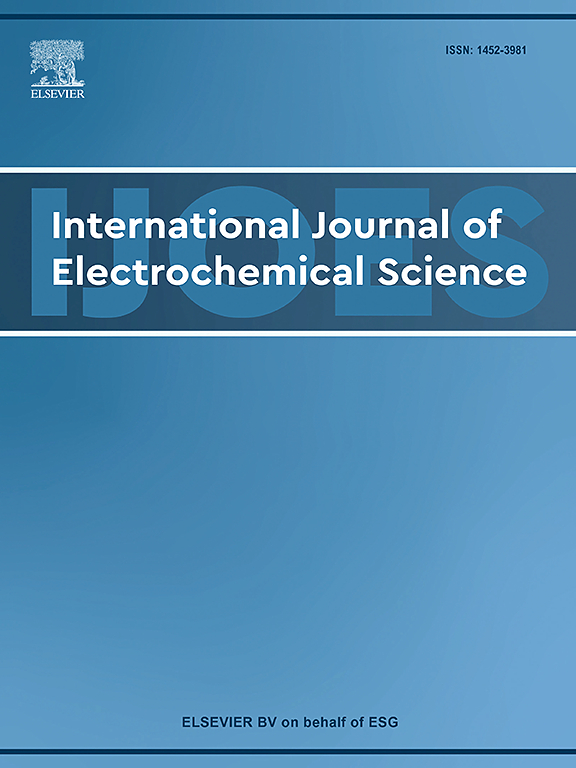Bi₂MoO₆/ go改性丝网印刷电极对瓶装水中锑的电化学检测
IF 2.4
4区 化学
Q4 ELECTROCHEMISTRY
International Journal of Electrochemical Science
Pub Date : 2025-04-08
DOI:10.1016/j.ijoes.2025.101018
引用次数: 0
摘要
锑(Sb)是塑料生产中常用的催化剂。由聚对苯二甲酸乙二醇酯塑料瓶引起的瓶装饮用水中存在的锑污染引起了极大的关注。锑的分析在很大程度上仍依赖于传统仪器。在这项研究中,我们利用钼酸铋(Bi2MoO6)和氧化石墨烯(GO)复合材料修饰的丝网印刷电极(SPE)开发了一种快速检测Sb的电化学方法。成功地合成并制备了Bi2MoO6作为电极。通过紫外-可见分光光度法、扫描电极显微镜(SEM-EDX)和X射线衍射仪(XRD)等多种仪器对其进行了表征。电化学分析结果表明,Sb3 +的浓度范围为0.04 ~ 0.64 μM,检出限为23 nM。结果表明,该方法具有良好的灵敏度、选择性、重复性和回收率。该方法在实际分析中使用了包装在塑料瓶中的饮用水,该塑料瓶事先已加热。回收率为99.96 %。这些令人鼓舞的结果,包括高灵敏度和几乎完全回收,突出了这种方法在确保饮用水安全和解决与塑料包装锑污染有关的问题方面的潜力。本文章由计算机程序翻译,如有差异,请以英文原文为准。
Electrochemical detection of antimony in bottled water using a Bi₂MoO₆/GO-modified screen-printed electrode
Antimony (Sb) is commonly used as a catalyst in plastic production. The presence of antimony contamination in bottled drinking water caused by polyethylene terephthalate plastic bottles has raised significant concern. Analysis of Sb is still largely reliant on conventional instruments. In this study, we develop fast detection of Sb using electrochemcial method with screen printed electrode (SPE) modified with bismuth molybdate (Bi2MoO6) and graphene oxide (GO) composite. The Bi2MoO6 has been successfully synthesized and fabricated as electrode. The characterization was confirmed by various instrument namely UV-Vis spectrophotometry, scanning electrode microscope (SEM-EDX), and X – Ray Diffraction (XRD). The performance of electrochemical analysis shows the linier concentration of Sb3 + in the range of 0.04 μM to 0.64 μM with a limit of detection (LOD) of 23 nM. Moreover, the sensitivity, selectivity, repeatability, and recovery were successfully achieved. This method was used in the real analysis using drinking water packaged in plastic bottles that has been previously heated. The result showed recovery of 99.96 %. The promising results, including high sensitivity and nearly complete recovery, highlight the potential of this approach for ensuring the safety of drinking water and addressing concerns related to antimony contamination from plastic packaging.
求助全文
通过发布文献求助,成功后即可免费获取论文全文。
去求助
来源期刊
CiteScore
3.00
自引率
20.00%
发文量
714
审稿时长
2.6 months
期刊介绍:
International Journal of Electrochemical Science is a peer-reviewed, open access journal that publishes original research articles, short communications as well as review articles in all areas of electrochemistry: Scope - Theoretical and Computational Electrochemistry - Processes on Electrodes - Electroanalytical Chemistry and Sensor Science - Corrosion - Electrochemical Energy Conversion and Storage - Electrochemical Engineering - Coatings - Electrochemical Synthesis - Bioelectrochemistry - Molecular Electrochemistry

 求助内容:
求助内容: 应助结果提醒方式:
应助结果提醒方式:


